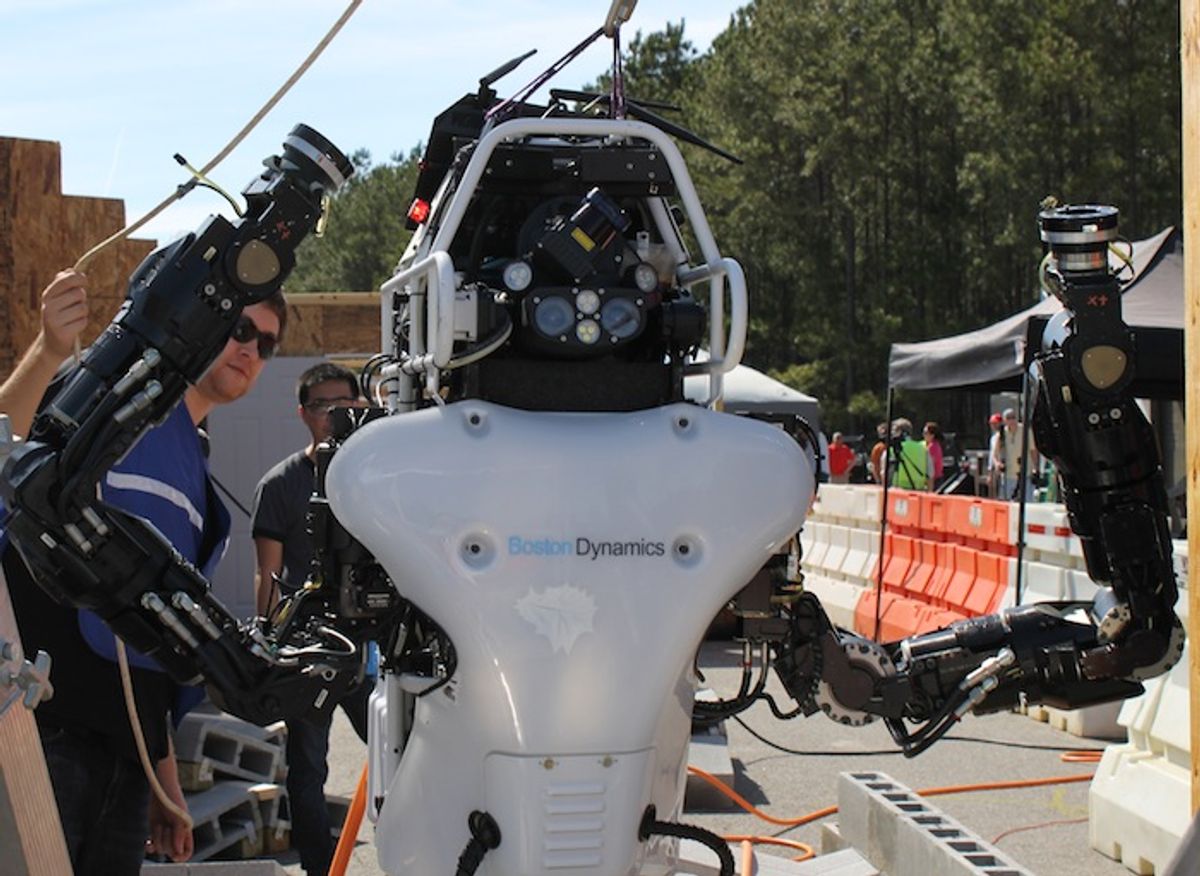The DARPA Robotics Challenge (DRC) just got bigger, more awesome, and more international. DARPA has just announced that 14 new teams from seven different countries have qualified to participate in the DRC Finals. These 14 teams join the 11 teams previously qualified during the DRC Trials.
This means a total of 25 teams will compete in what is possibly the most anticipated robotics event ever. Twenty five robots are a lot of robots. They will converge to the simulated disaster zone that DARPA will set up in Pomona, Calif., where the DRC Finals will take place in June.
In a call with reporters this afternoon, Gill Pratt, program manager for the DRC, said the tasks for the final challenge will be similar to the ones we saw at the trials. But this time the tasks will be “put together in a single mission” that teams have one hour to complete.
The robots will start in a vehicle, drive to a simulated disaster building, and then they’ll have to open doors, walk on rubble, and use tools. Finally they’ll have to climb a flight of stairs. But one more thing, Pratt said: there will be a surprise task waiting for the robots at the end.
Just when we thought the DRC couldn’t get any cooler—it just did. Naturally, Pratt declined to elaborate on what this mystery task might entail.
He also emphasized that now the robots will operate completely untethered. There won’t be cables to provide power and data—and to keep them from falling down. “They’ll have to get up on their own,” he said. “That’s raising the bar on how good the robots have to be.”
Seven teams are using the recently upgraded Atlas humanoid built by Boston Dynamics. The other teams have developed their own robots, which come in a variety of sizes and shapes. “We’re going to see a whole range of different approaches,” Pratt said.
The teams will score points based on how many tasks they are able to finish and how fast they perform them, competing for US $3.5 million in prizes.
The 14 newly qualified teams are:
Germany
- Team Hector (Technische Unversitat Darmstadt, Darmstadt)
- Team NimbRo (University of Bonn, Bonn)
- Team HKU (Hong Kong University, Hong Kong; Case Western Reserve University, Cleveland)
- Team Walk-Man (Istituto Italiano di Tecnologia, Genoa; University of Pisa, Pisa)
- Team Aero (University of Tokyo, Tokyo)
- Team AIST-NEDO (National Institute of Advanced Industrial Science and Technology, Tokyo)
- Team HRP2-Tokyo (University of Tokyo, Tokyo)
- Team NEDO-JSK (University of Tokyo, Tokyo)
- Team NEDO-Hydra (University of Tokyo, Tokyo; Chiba Institute of Technology, Chiba; Osaka University, Osaka; Kobe University, Kobe)
- Team Intelligent Pioneer (Hefei Institutes of Physical Science, Chinese Academy of Sciences, Changzhou)
- Team ROBOTIS (ROBOTIS, Seoul)
- Team SNU (Seoul National University, Seoul)
- Team DRC-Hubo (University of Las Vegas, Las Vegas)
- Team Grit (Grit Robotics, Grand Junction, Colo.; Colorado Mesa University, Grand Junction, Colo.; AutonomouStuff, LLC, Morton, Ill.; Harbrick, Moscow, Idaho)
To qualify for the Finals, the new teams had to submit videos to DARPA proving they could perform five sample tasks, which included walking or driving 10 meters without falling, going over a barrier, and operating a valve.
These 14 teams join the 11 teams that competed in the DRC Trials and earned enough points to automatically qualify for the Finals:
- Tartan Rescue (Carnegie Mellon University, National Robotics Engineering Center, Pittsburgh)
- Team IHMC Robotics (Florida Institute for Human & Machine Cognition, Pensacola, Fla.)
- Team KAIST (Korea Advanced Institute of Science and Technology, Daejeon, South Korea)
- Team MIT (Massachusetts Institute of Technology, Cambridge, Mass.)
- Team RoboSimian (NASA Jet Propulsion Laboratory, Pasadena, Calif.)
- Team THOR (University of California, Los Angeles, Los Angeles; University of Pennsylvania,
- Philadelphia)
- Team TRACLabs (TRACLabs, Inc., Webster, Texas)
- Team Trooper (Lockheed Martin Advanced Technology Laboratories, Cherry Hill, N.J.)
- Team Valor (Virginia Tech, Blacksburg, Va.)
- Team ViGIR (TORC Robotics, Blacksburg, Va.; TU Darmstadt, Germany; Virginia Tech, Blacksburg, Va.; Oregon State University, Corvallis, Ore.; Cornell University, Ithaca, N.Y.; Leibniz University Hanover, Germany)
- Team WPI-CMU (formerly Team WRECS - Worcester Polytechnic Institute, Worcester, Mass.)
[ DARPA Robotics Challenge ]
Updated 03/06/15 7:50 am ET
Erico Guizzo is the director of digital innovation at IEEE Spectrum, and cofounder of the IEEE Robots Guide, an award-winning interactive site about robotics. He oversees the operation, integration, and new feature development for all digital properties and platforms, including the Spectrum website, newsletters, CMS, editorial workflow systems, and analytics and AI tools. An IEEE Member, he is an electrical engineer by training and has a master’s degree in science writing from MIT.



